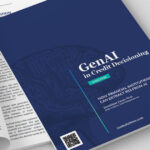A recent report from the World Bank shows that “[g]lobally, 1.7 billion adults remain unbanked.”[1] In the US, the underbanked and unbanked (U/U) group comes in at just under a quarter of the population. That translates to nearly 75 million Americans without bank services, or who use alternative financial products like payday loans, check cashing services and money orders.
These people have the same money management and credit needs as individuals with access to traditional bank services, but they are excluded from those services – for a variety of reasons. Some are intentionally avoiding banks, but many just cannot get the products they need.
These consumers can represent a great opportunity for financial institutions who are willing to invest in them. Organizations should be looking for ways to engage with and provide services to this population, and the best way for a bank or other financial institution (FI) to manage risk and say “yes” is to improve access to data.
With the wide variety of emerging and alternative data available, FIs can inform their decisions while improving financial inclusion for the folks who need it most.
Population Overview of the Unbanked & Underbanked
In the US, FIs rely heavily on traditional credit bureau data to make credit decisions. Currently, close to 57% of Americans have a FICO credit score of 700 or higher, placing them in the near-prime, prime and super-prime categories.[2] For FIs, engaging with these consumers represents a low risk approach with good potential return, creating little need to obtain additional data to make an approve/decline decision.
These consumers are the “known entities” of the financial world. They have an established credit history and readily accessible bureau data. Banks can use this traditional information, including credit score, to make their decisions.
For the remaining 43% of Americans, getting access to the financial products they need can be much more challenging. These people are the “unknown entities” of the financial world, and they stand in stark contrast to the top tiers of known consumers.
Unbanked and underbanked consumers are disproportionally likely to be from minority groups. Across the US, 5% of the population is unbanked, while 18% is underbanked. But in minority populations (Black, Hispanic, Native American and others) the rates of unbanked consumers average roughly 11%, and underbanked consumers range from 26-36% of the population.[3]
Minorities are not the only groups fighting for inclusion. Millennials, new-to-country immigrants and seniors all face challenges with access to traditional financial products. Estimates for underbanked millennials range as high as 55% of the population,[4] while a recent American Banker article notes: “there are 10 million immigrants…who are very likely to be prime to super prime, but are captured by U.S. credit bureaus as thin files at best.”[5]
Financial Inclusion for the Unbanked & Underbanked
Estimates for the potential market size of unbanked and underbanked consumers range from $188 billion[6] to “a whopping $380 billion”.[7] FIs that can identify and engage with these groups stand to gain new business, significant revenue and a loyal set of customers.
FIs have options when it comes to serving this market. Of course, any organization needs to balance risk with customer acquisition – and that is precisely where access to new, emerging and alternative data can help.
Alternative data can open a window into consumer risk profiles that simply did not exist until recently. With the increase in available information, as well as the ability for FIs to access, interpret and decision on this data, organizations have a “more complete, thorough perspective of … applicants, who may otherwise go overlooked.”[8]
Whether they access rental records, employment history, alternative credit scores or other sources of data, FIs can use that information to gain a new perspective on an applicant that does not have a traditional credit file. Using that new insight, an organization can make an informed decision and provide options for financial inclusion to the people who need it most.
Data is the Key
The lynchpin to all of this is real time access to data from virtually any internal and external source. Using an enterprise decisioning layer, like the one provided by Zoot, any company can use traditional, alternative, new and emerging data to make the best credit decisions. With a data agnostic, enterprise approach, FIs can tap into the unbanked and underbanked market without exposing themselves to unnecessary risk.
[1] The World Bank. (2018, April 19). Financial Inclusion on the Rise, But Gaps Remain, Global Findex Database Shows. Retrieved September 17, 2018, from http://www.worldbank.org/en/news/press-release/2018/04/19/financial-inclusion-on-the-rise-but-gaps-remain-global-findex-database-shows
[2] Frankel, M., & CFP. (2017, September 28). Here’s What Americans’ FICO Scores Look Like — How Do You Compare? Retrieved September 14, 2018, from https://www.fool.com/credit-cards/2017/09/28/heres-what-americans-fico-scores-look-like-how-do.aspx
[3] Wojciechowski, W. (2017, December 23). Unbanked vs. Underbanked: Who They Are and How They Differ. Microbilt. Retrieved September 10, 2018, from http://www.microbilt.com/news/article/unbanked-vs-underbanked-who-they-are-and-how-they-differ
[4] Pymnts. (2017, March 27). Topic TBD: Reaching The Unbanked Generation. Retrieved September 07, 2018, from https://www.pymnts.com/news/retail/2017/topic-tbd-reaching-the-great-unbanked-generation-millennials-movocash-underbanked-recession/
[5] Wisniewski, M. (2018, February 09). Fintechs Find Another Untapped Market: New Immigrants Needing Credit. American Banker. Retrieved September 12, 2018, from
[6] Wilson, E., & Wolkowitz, E. (2017). 2017 Financially Underserved Market Size Study (p. 4, Rep.). CFSI.
[7] Lala World. (2017, October 24). Banking the Unbanked: A Risky Proposition or a Market Opportunity? Techburst. Retrieved September 03, 2018, from https://techburst.io/banking-the-unbanked-a-risky-proposition-or-a-market-opportunity-28a8c5436ece
[8] Richard, D. (2017, April 20). Demographics of Underbanked Completes Picture of Prospects. FactorTrust. Retrieved September 16, 2018, from https://ws.factortrust.com/2017/04/20/demographics-of-underbanked-completes-picture-of-prospects/[/vc_column_text][/vc_column][/vc_row]





